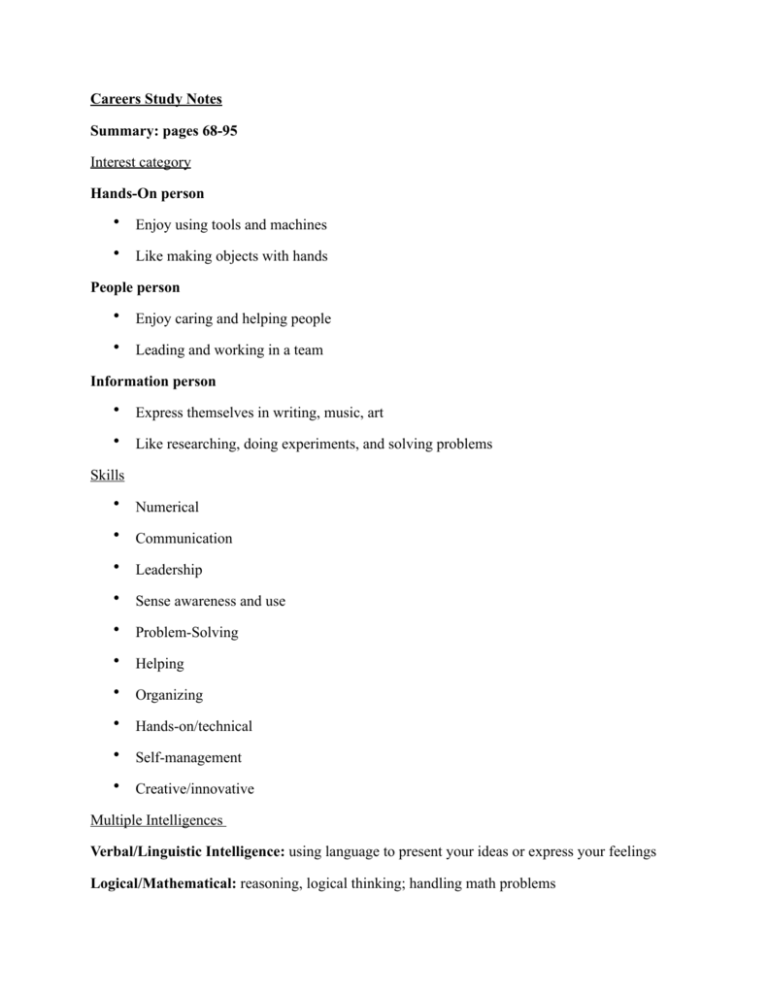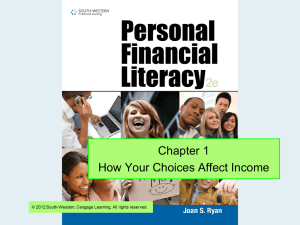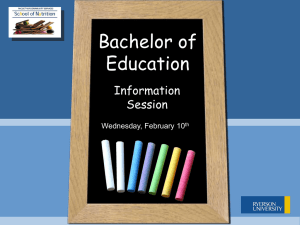Careers Study Notes Summary: pages 68
advertisement

Careers Study Notes Summary: pages 68-95 Interest category Hands-On person • Enjoy using tools and machines • Like making objects with hands People person • Enjoy caring and helping people • Leading and working in a team Information person • Express themselves in writing, music, art • Like researching, doing experiments, and solving problems Skills • Numerical • Communication • Leadership • Sense awareness and use • Problem-Solving • Helping • Organizing • Hands-on/technical • Self-management • Creative/innovative Multiple Intelligences Verbal/Linguistic Intelligence: using language to present your ideas or express your feelings Logical/Mathematical: reasoning, logical thinking; handling math problems Visual/Spatial Intelligence: creating and interpreting visual images Bodily/Kinaesthetic Intelligence: feeling and expressing things physically (hands-on) Musical/Rhythmic intelligence: Creating and feeling rhythm to express mood (analysing music) Intrapersonal Intelligence: understanding your own interior thoughts Interpersonal Intelligence: understanding the feelings and needs for others Naturalist Intelligence: understanding nature, seeing patterns in the way nature works Summary: Pages 96-122 Learning Styles Auditory • Learn by hearing • Need to read material out in their head • Prefer to hear rather than read Strategies to improve learning • Listen to audio-visual aids such as videos or films • Memorize and repeat things over and over Visual • Learn best by seeing • Can visualize words numbers and pictures in their mind. • Often need a place where there are no visual distractions. Strategies to improve learning • Write out everything • Ask teachers to write things out on the blackboard • Watch movies to use the visuals to learn. Kinaesthetic • Learn by doing and moving • Learn most by writing out facts and info • Like to be shown how to do things. Strategies to improve learning • Act out a poem, story or event • Build models or draw pictures to illustrate your thoughts • Participate in role-playing, sports, charades, etc Personality and Accomplishments Organiser Manager Type • Makes decisions, Takes responsibility and enjoys organising and managing events. Social/Helper • Explains things to others, helps friends to solve problems, works as a group, encourages others. Fixer/Builder • Works with objects, uses tools and machines, figures out ho things work. Creator/Innovator • Tries new things, uses imagination, uses original ideas, and enjoys being challenged. Doer/ Detail • Works at steady pace, prepared before starting something and follows instructions. The Six Personality Types Realistic: Technically and athletically inclined people, prefer to work with their hands/tools Investigative: Abstract problem solvers prefer to work on their own observing and investigating. Artistic: Idea creators prefer to work with their minds innovating and imagining. Social: People helpers like to work with people informing and enlightening. Enterprising: People influencers like to work with people influencing and leading. Conventional: Data and detail people prefer to work with words and numbers Personal Management Skills Time Management: Using you rime appropriately Organisation: Keeping your information sorted` Problem Solving: Using deductive skills to find the answer Decision Making: Choosing between several options Being Responsible: Taking account upon your own actions Positive Attitude/Behaviour: Staying upbeat and happy through bad times Continuous Learning: Non-stop absorption of knowledge Showing Initiative: Starting when no one else will start Working Safely: Being cautious in your job environment Being Adaptable/Flexible: Going with the flow of the ever changing situation Setting and Achieving Goals: Creating a point in which you would like to be at, and reaching that point. Summary: pages 123-144 Understanding the Ontario Secondary School Program Types of courses in grade 9 and 10 • Academic (D) • Applied (P) • Locally-developed (L) • Open (O) • Gifted (G) • Advanced placement (E) Types of courses in grade 11 and 12 • College (C) • University/college (M) • University (U) • Work place (co-op) • Open (O) What you need to graduate • 4 credits in English • 3 credits in math • 2 credits in science • • • • • • • • • • • • 1 credit in Canadian history 1 credit in Canadian geography 1 credit in the arts 1 credit in health and Phys. ED 1 credit in French as a second language 0.5 credit in career studies 0.5 credits in Civics Group 1 Group 2 Group 3 40 hours of community service Completed and passed Ontario Secondary School Literacy Test Important Definitions • Transcript: Legal document that tracks the students overall achievements in high school. It is needed by post-secondary institutes for admission. • Full Disclosure: In grades 9 and 10, only successfully completed courses appear on transcript. In grade 11 and 12, all attempted courses appear if not dropped before the full disclosure deadline. For students who do not achieve OSSD 1. Can receive an Ontario Secondary School Certificate who will be leaving the school before completion. Must have at least 14 credits in: • 2 credits in English • 1 credit in Canadian History or Geography • 1 credit in Math • 1 credit in Science • 1 credit in Heath and Phys Ed • 1 credit in the Arts or Technological Education 2. Can receive The Certificate of Accomplishment if they can no receive an OSSC or an OSSD. Introduction to Colleges to Universities Colleges • Practical Type of educational • Hands on experience/learning University • Theoretical • Abstract thinking What do you receive upon completion of the program? Duration of the programs How many there are in Ontario Tuition • • • • • • Diploma Certificate College degree 1 year – 3 years (depends on the program) 24 public • D e g r e (undergraduate) e • 4 years • 23 public $3,500+ (depends on the program) • • $5,000+ (depends on the program) College types • Certificate Programs: One year programs • Diploma Programs: 2 years of study / Advance Diploma: 3 years of study • Co-Op Programs: Integrates real life experience with in school training • Graduate Certificate Programs: After completing study in a post-secondary program, you can acquire this. (Cannot apply directly from high school) • Bachelor’s Degree Programs: Requires 4 years of study. (Usually have same prerequisites as university bachelors) • Joint College-University Programs (Collaborative): These programs combine hands on college learning with theoretical university approaches. Can earn both a college diploma/ university degree. Pre-requisites are same as university bachelor programs • Apprenticeship: 75-90% of learning is dedicated to on-job training. Paid work and can earn hours required for the certification Articulation Agreements: Transfer from college into university in the 2nd or 3rd year Highly Competitive/Oversubscribed Programs: More applicants than space, need high marks to get into these types due to many others with similar marks. Determining admission: • Average of 6 courses (best) • Average of 4 courses (best) • Pre-requisites • Admission testing If a grade 12 pre-requisite course is taken in 2nd semester? • Grade 11 marks are taken into consideration • Admission testing (Competitive programs might put you at a disadvantage if you have a pre-requisite 2nd semester) Grade differentials: Bonus marks are given if you take compulsory credits at the U level How colleges look at different types of credits: Different colleges look at different credits, whereas one might look for workplace courses, while others might only look at C, M, or U level courses. Advantages of going to college • Cost-effective • Affordable ( basic information, faster stream into the workforce) • Wide program selection • Many locations • Small classes • Connected education to workplace Fee: $95 When to apply? : Before the equal consideration date What is the equal consideration date? : To be considered the same marks as others (first come, first serve) When is it generally? : February 1st How are your grades sent if you are taking a high school in Ontario? : Guidance office Summary: pages 145-164 All About University Main purpose of university is to help you refine your higher-level thinking skills Types of programs -Undergraduate (3-4 years) BA= bachelor of Arts BSc = bachelor of science BComm = Bachelor of Commerce BFA = bachelor of fine arts -Masters (1-2 years) -Doctor of Philosophy - PhD (4-5 years) How to apply to a University in Ontario -Through Ontario Universities` Application Centre (OUAC) T-wo types of applications: 101(students currently registered in a Ontario Secondary School) and 105 Admission Requirements for Ontario Universities -based on top 6 in grade 12 OUAC 6 types of applications -101 current OSS students -105 any other undergraduate -Ontario Faculties of education -Ontario Medical Schools -Ontario Rehabilitation Science programs -Ontario Law Schools eINFO Website On eInfo, you can find programs, search for scholarships, search residence packages/meal plans, find useful info (tuition and fees), to pinpoint university locations. Browse programs by University or Programs The Addenda outlines updates that have been made to program details. It’s important because updates are always made and it affect whether we want to apply or not. Apprenticeships An apprenticeship is a paid job that provides hands-on training for people who want to work in a skilled trade and enjoy learning by doing. 4 main pathways to an apprenticeship -­‐ Enrol in Ontario Youth Apprenticeship Program (OYAP) -­‐ Find qualified employer willing to hire you as apprentice -­‐ Take pre-apprenticeship programs through college, unions, and trade association -­‐ Enter co-op (college) diploma Apprenticeship program Four main groups of skilled trades -­‐ Motive power sector –servicing cars, marine engines, heavy equipment, etc. -­‐ Construction - building buildings -­‐ Service – variety, from personal and business services to tourism and hospitality -­‐ Manufacturing or Industrial – precision machining To become an apprentice, you need to have finished high school and other specifics depending on the employer. Steps for Decision Making 1. Identify the decision to be made and identify options 2. Gather Information 3. Analyze your options 4. Make a plan 5. Reflect on your plan Summary : Pages 165- 173 + Truth About You Main theme: Employee Safety • Employment Standards Act o Provincial law that contains Ontario’s basic rules about employing people o Under the act employers and employees have rights and responsibilities. o The act covers hours of work and paid time off, role of Ministry of Labour, minimum wage, methods of payment, pregnancy and parental leave, layoffs. • Other laws that apply: Federal, Ontario Human Rights code. • Regulates health and safety in Ontario workplaces: Occupational Health and Safety Act (OHSA) • Workplace Safety and Insurance Act: promotes healthy, safe workplaces to encourage safe timely return to work and provide insurance. • Occupational Health and Safety Act (OHSA) regulates Ontario workplaces other than those regulated by the Canada Labour Code o Rights under OHSA § Employer must inform you of any hazards in your workplace and provide training so you can work safely § You have the right to participate in health and safety issues in your workplace § Right to refuse work you believe is dangerous to your health and safety of another worker. *Know the 3 rights of every worker • Right to participate in health & safety issues • Employer must inform you of any hazards to provide training • To refuse unsafe work *Know the 4 responsibilities of every worker according to the Occupation Health and Safety Act • Inform yourself on your rights • To work safely • To report any unsafe condition or occurrence • To report any injury *Know what Workplace Hazardous Materials Information System stands for and the different components of WHMIS The Truth About You • 3 Myths that can Hold You Back o As you grow older your personality changes § You become more of who you are § Strongest part of personality remains that same o If you want to grow, if you want to get better you can’t rely on your strengths, you need to figure out what your good at and you need to work at getting better at it § Shouldn’t ignore weakness but you shouldn’t work on weaknesses § Work on strengths o The best teams have a group of well-rounded people all playing every role equally well § Best teams are made up of people who have figure out their strengths are and surround themselves with people who are strong where they are weak • Strengths are things that you enjoy doing not things you are good at • Weaknesses are things that you do not enjoy, things that make you feel weaker, not things that you are bad at Summary: pages 175-211 Page 174 & 175 Resume – Outline Information • Resumes must be clear, concise and grab the attention of the reader • Two types resumes: chronological and functional o Provides same information but in different formats • Chronological Resume o Advantages: § Summary of education and experience o Disadvantages: § • No place to indicate skills and qualifications up front Functional Resume o Advantages: § Highlights special skills and any awards and achievements that come from work, volunteer or school experiences o Disadvantages: § May not have examples Page 179 Resume Do’s and Dont’s • Keep the resume brief, clear and concise • No spelling/grammar mistakes • Tailor resume to suit the position you are applying for • Avoid listing unnecessary info The Cover Letter – Information Sheet Purpose of Cover Letter • Introduces you to employer • Gets employer’s interest • Connects you to specific position • Requests a meeting with employer Best Practices • Length o One page max • Format • Use of language Anatomy • The ‘three paragraph’ cover letter • Intro • Body • Conclusion Tone of Cover Letter Short Three or four brief paragraphs One page Personal Focused Researched Interesting Request for Action Appealing to eye Name/Title of hiring manager Make details relevant to job Refer to organization’s goals and needs Demonstrate enthusiasm Make clear interest in position Same quality paper as for resume Structure of Cover Letter Address Date Addressee Salutation First Paragraph Full name, full address, city, country, area code, telephone numbers, e-mail Address letter to right person; make sure name, title, and address are accurate Addressee’s full name, their professional title, their organization name, mailing address, city, country, area code Mr. or Mrs. State why you are writing; position applied for; general comment about company. Should command attention Second Paragraph State job or position applied for State academic qualifications and job experience Third Paragraph Highly relevant to job applied for Say you will follow up (and do so) Closing Request action Yours sincerely; Sincerely yours; Yours truly Your signature Your name Enclosure The Interview (203) Before the interview make sure you have a lot of knowledge on the company Visit the company, talk to someone inside the company to learn about the company. Visit their website (if it exists). Make sure you are prepared for the interview Prepare questions for the interviewer, bring a copy of your resume, prepare for their questions, be clear about your skills, dress well, be on time and take notes on key points of the interview. Upon arriving for your job interview for the interview, remember that you must impress the employer to help your chances being hired. Be 5-15 minute early, speak clearly, maintain good posture, don’t chew gum or fidget, make solid eye contact, don’t show that you are nervous and be honest and sincere. Send a follow-up (Thank You) letter no later than two days after the interview to maintain a good impression. Do’s and Don’ts (204) – 203 and 204 are repetitive Rehearse, consider the position and what to wear, arrive alone, relax, be confident, consider ahead of time what is going to be asked, come prepared, offer a solid handshake, don’t get thrown off by odd questions, ask for clarification if you are unsure of a question, understand the job description, look the interviewer in the eye, be aware of your body language, answer questions accurately and efficiently, be professional, be honest, be prepared to relate your personal experience to the job, listen, be polite, make sure the interviewer is in control, do not talk negatively about your current employer, be ready to ask questions, find out when a response is expected, if it is a phone interview make sure to have an appealing tone and be sure to send out a thank you letter. HOW TO WRITE A GOOD COVER LETTER 1. Address the person that the cover letter is going to and know their name correctly. 2. Show the little knowledge that you have of the company researching may be needed to be aware of the companies problems or needs 3. Show enthusiasm and interest in their line of work, and if you have any ideas that may resolve any problems that the company has offer to discuss about it. 4. Project warmth and friendliness while still being professional. 5. State facts that set you apart from others and make you unique and also relevant and helpful to the job being a applied to 6. Be specific to what it is you are asking for and offering to the job making sure it relates to the job 7. Keep it brief a cover should not be more than a few paragraphs on one page.





